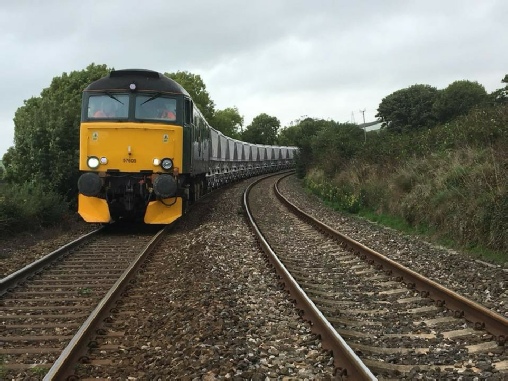Archive Section
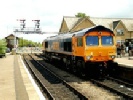



Tuesday 18th September 2018
© Malcolm Pym & Stuart Smith.
Our group arrived at Plymouth off varying trains, where we met our host from Network Rail (Craig Munday, Mobile Operations Manager) on platform four. After formalities and a short briefing we were escorted through the security access gate on the former parcels platform and into the grey brick building which houses Plymouth Panel Signal Box, as well as rooms which serve for the MOM’s and P-
One of our group (Brian Holyland, a former Signaller at Greenford East) was instantly recognised by a former colleague from the London area. We moved through to the operating floor of the box, which overlooks the west-
The current panel box dates from 1960, and upon its opening replaced four mechanical boxes in the station vicinity: North Road East, North Road West, Mutley & Mannamead. Over the next few years (until 1973), the former boxes at Laira Jct, Keyham, Saltash and St Germans were also closed and incorporated into the Plymouth operation. From 1973 through to today, the area controlled remains the same.
The two signallers on duty (Jerry Gould and Andy Greening) gave us a detailed explanation into the workings of the area and the signalling systems used. The numerous line blockages being requested and taken by P-
We had agreed to meet Craig here at 14:00 (he had driven by road, as he was officially on duty), so this gave us time to take lunch in a nearby eatery before continuing our visit.
We arrived back at the station just as an HST was arriving from London (about 10mins late), and also witnessed the departure of the local branch service to Newquay, which was held for a few minutes to allow for connecting passengers to transfer between services. Just as our visit was due to start, a DB-
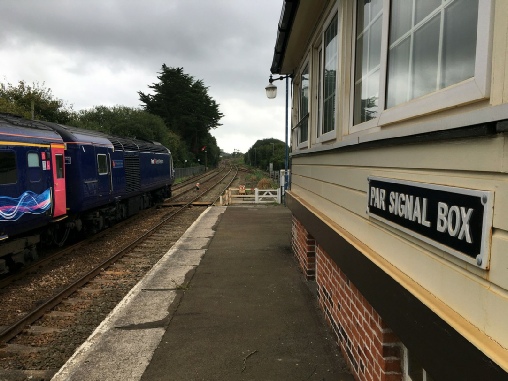
The Cornish Rivera calls at Par with 43056 ‘The Royal British Legion’ leading
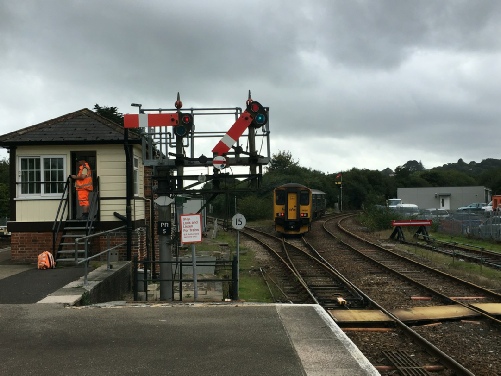
A Class 150/2 leaves Par for Newquay
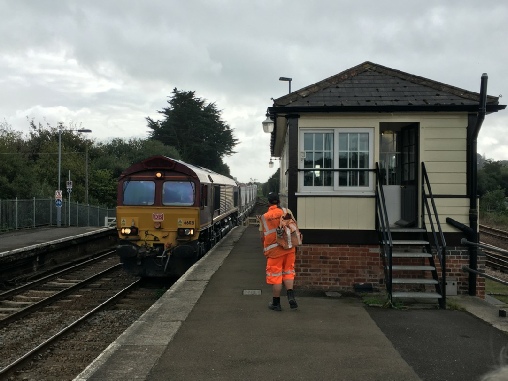
66031 arrives into Par with 6P24
Craig invited us into the signalbox where met the duty signaller, who explained the workings of the various levers and instruments. The sound of the bells and block equipment was like stepping back in time!
The box here is original and dates from 1879, although it was enlarged in 1913 to house 57 levers, which it retains to this day. A small panel section has been added to control the colour-
Before too long, the expert eyes of both the signaller (and Craig) were noticing that the freight we had seen earlier had still not cleared the section, despite having had a clear run. There fears were confirmed when a GSM-
Several phone calls to neighbouring boxes followed without pause (to get subsequent trains held back) and also to GWR at Long Rock asking for a possible use of the ‘Night Riveria’ Class 57/6 as a rescue locomotive. [For the record, the nearest DB loco was at Westbury].
It was pleasing to see a high level of professionalism by those involved and how the various companies; Network Rail, DB Schenker & GWR all seemed to work together locally.
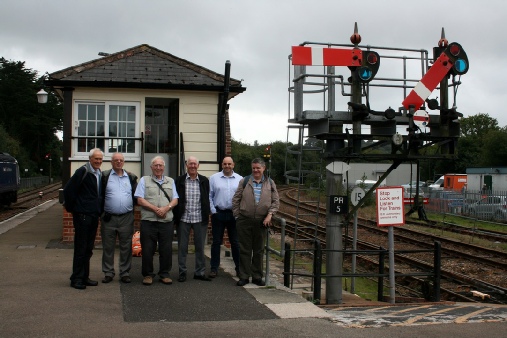
Members stand outside Par Signal Box
We boarded the 15:06 service to London Paddington (formed of 2x 5-
We eventually left Par at 16:27 (81 mins late) and travelled wrong line to Lostwithiel under SLW conditions with a pilotman. We passed the stricken freight train still some way short of the summit at Treverin Tunnel. The arrival into London was at 20:24 (just over an hour late), helped by an alteration to calling points, which made the service from Plymouth; for Exeter, Reading and Paddington only. From Reading to London the IET’s operate in electric mode, and the difference in speed of acceleration was clearly noticeable between this and diesel-
All in all, the visit had been a great success, and allowed members to see the vast differences in signalling practices between the two locations. My thanks go to Craig Munday for arranging the visit, and to the staff we met on the day.
* As a footnote, 57605 ‘Totnes Castle’ did get sent from Long Rock Depot at Penzance to assist the failed train. The loco was used to drag the freight train back to Par and into the freight yard at St Blazey. The GWR engine then returned to Penzance to be in position to work its booked overnight train at 21:45.
GWR engine 57605 rescues 6P24 on a china clay train
